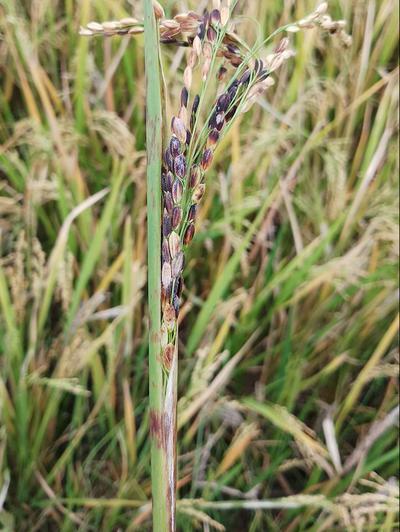Sheath Rot of Rice
Sarocladium oryzae
Fungus
In a Nutshell
- Spot-like lesions on uppermost leaf sheaths.
- Rotting of sheaths.
- Whitish, powdery fungal growths with discolored grains.
Can also be found in
Symptoms
Early symptoms are oblong to irregular spots on the leaves (0.5 to 1.5 mm) that enclose the panicles. Spots are characterized by gray centers and brown margins and often merge to form rotting and then discoloration of the leaf sheaths. In severe infections, the young panicles may not emerge. Affected leaf sheaths may have abundant whitish powdery fungal growth visible on the outer surface. Grains of emerged panicles become discolored and sterile. Un-emerged panicles produce florets that turn red-brown to dark brown. Infection is most damaging when it occurs at late booting stages and can cause severe damage.
Recommendations

Organic Control
Bacteria such Rhizobacteria of Pseudomonas fluorescens isolated from citrus and rice are toxic to the rice sheath rot fungus, resulting in lesser incidence and more yield. Bipolaris zeicola is another potential antagonist of sheath rot that can completely inhibit mycelial growth of S. oryzae. Antifungal activity of extracts from leaves and flowers of Tagetes erecta also inhibit S. oryzae mycelium by 100%.

Chemical Control
Always consider an integrated approach with preventive measures together with biological treatments if available. In case of severe infestation, the application of fungicides such as mancozeb, copper oxychloride or propiconazole (usually 1 ml/l of water) during booting and panicle emergence at weekly intervals can reduce the incidence of the disease. Application of a seed treatment fungicide like mancozeb before sowing is also effective.
What caused it?
Sheath rot is principally a seed-borne disease. The disease is caused principally by the fungus Sarocladium oryzae but also in some cases by Sacroladium attenuatum. The fungi survive on rice crop residue after harvest and can cause infection in following seasons. Its incidence increases with increasing planting density and in plants that provide entry points for the fungus, in the form of injuries and wounds caused by insects at panicle initiation stage. The application of potassium, calcium sulphate or zinc fertilizers at the tillering stage strengthen the stem and leaf tissues and thus avoid extensive damage. It is also associated with plants weakened by virus infections. Hot (20-28°C) and humid (wet) weather favor the growth of the disease.
Preventive Measures
- Use healthy seeds, if possible from certified sources.
- Use wider planting distance of 25cm x 25cm.
- Avoid monocultures in same field by using at least two varieties.
- Survey the fields regularly for insects pests like panicle mite and try to keep them under control.
- Apply potassium, calcium sulfate or zinc fertilizers at the tillering stage.
- Removal of infected stubbles and weeds from the field also helps.



